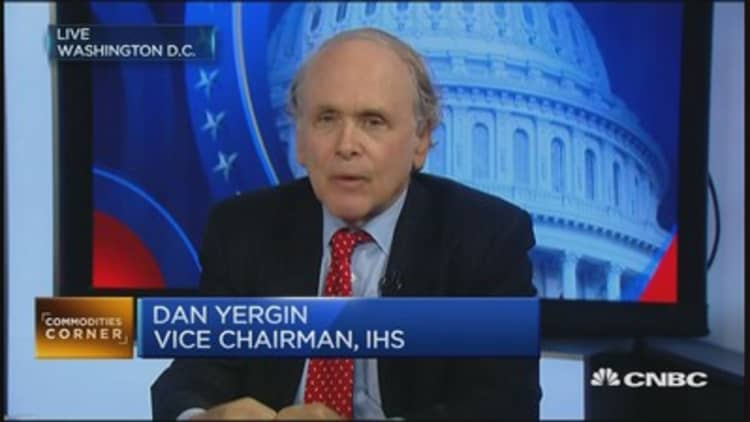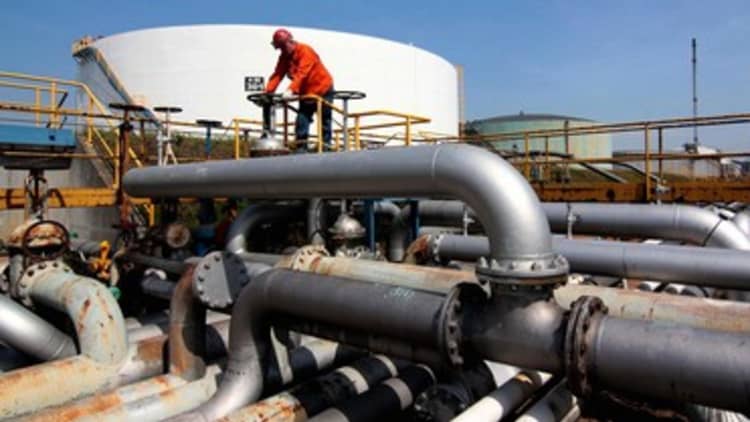



It's not just fundamentals; oil prices are being slammed by a severe erosion in market confidence caused by the fragile global environment, according to a top commentator on energy and geopolitics.
Dan Yergin, vice chairman of consultancy IHS, told CNBC that worries stemming from Iran to China were key to the oil price.
"It's not just supply and demand…this time, oil prices are also being hammered by geopolitical factors and being hammered by geo-economical factors," Yergin said.
One big question for the market is when Iran would come back into the market and how much oil it would produce once U.S. sanctions are lifted, he said.
"There's not been an accommodation possible in OPEC…Saudi Arabia and the Gulf countries are not going to cut back, to make room for Iran coming back into the market," Yergin told CNBC's Squawk Box on Wednesday.
At its half-yearly policy meeting in December, OPEC decided not to lower its 30 million-barrel-day production quota, as kingpin Saudi Arabia stuck to its strategy of maintaining output in order to push prices down, squeezing out smaller energy players with higher production costs.
The market was also scratching its head over China's growth prospects, Yergin said.
"The big worry is (whether) China (is) going to be the engine not of economic growth in the world but the engine of an economic downturn which would affect demand; that is one of the uncertainties that here in the January of 2016, we don't know the answer," he said.
Speaking to CNBC on Wednesday, Doug Gordon, senior portfolio manager at Russell Investments, agreed on the risks posed by the world's second-largest economy.
"We've transplanted the fears and risks coming from China and supplanted those with low oil price. It's a case where what happens in China.. doesn't seem to stay in China," Gordon said.
On the demand side, oil consumption was holding firm, with growth in 2015 more than doubling on 2014 as Americans drove more due to low gasoline prices. Demand growth in 2016 would likely not beat 2015 but would still outperform 2014, Yergin predicted.
While there were now revised forecasts for even lower oil prices, with Standard Chartered calling $10 a barrel, Yergin said the industry would need to run out of storage space to that depressed level — a situation that IHS's data does not support.
Justifying the bold call, StanChart said that oil prices were being moved almost entirely by financial flows caused by fluctuations in other asset prices, which meant that no fundamental relationship was driving the market towards any equilibrium.
"With Saudi Arabian oil spokespeople remaining relatively quiet as prices fall, and with high inventories and the expectation of more supply blunting any potential market concern over geopolitical tensions, the sources of short-run support are fairly limited. In the extreme case, the only definition of a floor would come when the entire market felt that prices had undershot too far," the bank's analysts wrote.
The last time crude oil fell to $10 was between 1996 and 1998, when the industry ran out of storage space.
The oil selloff only two weeks into 2016 had spooked markets and accelerated a decline that has pushed prices down by about two-thirds since July 2014. Since the beginning of the year, oil has lost almost 20 percent, with U.S. WTI light sweet crude slipping below $30 a barrel for the first time in 12 years overnight.
Oil prices rebounded on Wednesday in Asian hours, with WTI jumping as much as 2.2 percent, although prices were still below $31 a barrel. The global benchmark, Brent crude, rose as much as 1.6 percent and was last up 0.5 percent at $31.02 a barrel.
According to trade data released today, China's crude oil imports hit a record 7.82 million barrels a day in December, as the world's second largest oil consumer stocked up its strategic reserves on the back of low prices.
The price gains also come after U.S. crude oil stocks unexpected decline in U.S. stocks of 3.9 million barrels last week, data from industry group American Petroleum Institute showed.
"There's nothing magical between $29 to $31 (a barrel) but it does reflect this kind of downward momentum ... Psychologically, it's looming there, even more than $40 did, just because it's been such as shock how far prices have come down. [People thought] $100 a barrel was going to be there forever," Yergin said.
IG market analyst Lucas Evans said that as oil producers are pushed out of business, the forces of supply and demand would rebalance.
"The question is where the supply cuts will come from," he said said in a note.
British oil and gas company BP announced plans on Tuesday to cut 5 percent of its 80,000 global workforce amid the oil downturn, with cuts mostly from the upstream segment.
— Reuters contributed to this report.


